@zy-0815
2016-11-27T17:41:31.000000Z
字数 3961
阅读 1458
计算物理第十次作业Problem4.8
摘要
上次作业研究了桌球的碰撞问题,而此次作业将重点放在了大家熟悉又陌生的太阳系中。
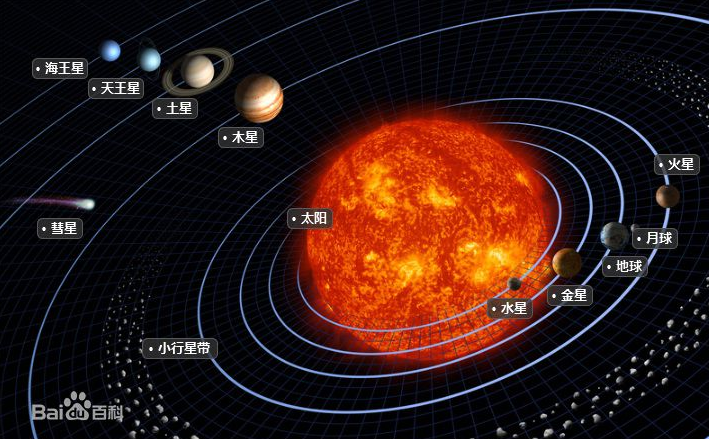
背景
已知在天体运动中天体遵循万有引力定律:
将太阳运动分解为x,y轴方向可以得到:
由Euler-Cromer方法可以处理上面式子,并取初始条件为x=a(1+e),y=0,同时有:
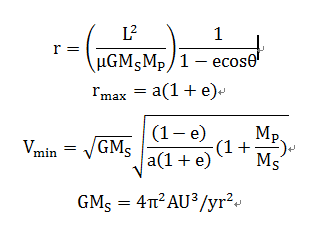
此时一个简单的模型已经出来了,但不足之处有未考虑相对论等效应。
正文
1. 行星椭圆运动
程序为:
import pylab as plimport mathclass Solar_system :def __init__(self,i=0,initial_x=1,initial_y=0,initial_vx=0,initial_vy=2*math.pi,\total_time=10, time_step=0.002, radius=1):self.x=[initial_x]self.y=[initial_y]self.vx=[initial_vx]self.vy=[initial_vy]self.r=[radius]self.time=total_timeself.dt=time_stepself.t=[0]def run(self):_time=0while(_time<self.time):self.vx.append(self.vx[-1]-4*pow(math.pi,2)*self.x[-1]/pow(self.r[-1],3)*self.dt)self.x.append(self.x[-1]+self.vx[-1]*self.dt)self.vy.append(self.vy[-1]-4*pow(math.pi,2)*self.y[-1]/pow(self.r[-1],3)*self.dt)self.y.append(self.y[-1]+self.vy[-1]*self.dt)self.t.append(_time)_time += self.dtdef show_results(self):pl.plot(self.x,self.y)pl.title('Solar system')pl.xlabel('x(AU)')pl.ylabel('y(AU)')pl.legend()pl.show()a = Solar_system()a.run()a.show_results()
运行结果为:
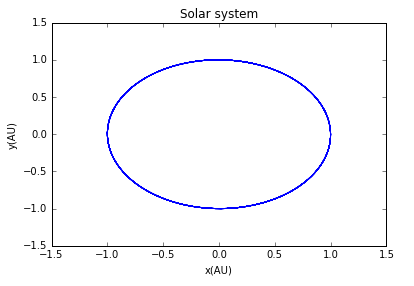
当改变e值时即可改变轨道形状,可得结果:
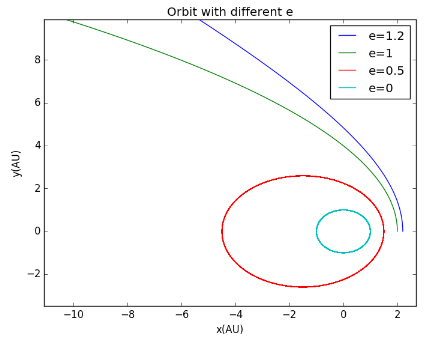
2 不同β运动轨迹
以水星为例,取β=2、2.01、2.1、2.5的轨道轨迹,程序如下:
import pylab as plimport mathdef initial(a,e,MP,beta):MS=2*10**(30)x0=a*(1+e)y0=0vx0=0vy0=2*math.pi*math.sqrt((1-e)/(a*(1+e))*(1+MP/MS))return [x0,y0,vx0,vy0,beta]class orbits():def __init__(self,x0,y0,vx0,vy0,beta):self.x=[x0]self.y=[y0]self.vx=[vx0]self.vy=[vy0]self.dt=0.001self.t=[0]self.steps=2000self.r=[]self.beta=betadef calculate(self):for i in range(self.steps):self.r.append(math.sqrt(self.x[i]**2+self.y[i]**2))temp_vx=self.vx[i]-4*math.pi**2*self.x[i]*self.r[i]**(-self.beta-1)*self.dtself.vx.append(temp_vx)temp_x=self.x[i]+self.vx[i+1]*self.dttemp_vy=self.vy[i]-4*math.pi**2*self.y[i]*self.r[i]**(-self.beta-1)*self.dtself.vy.append(temp_vy)temp_y=self.y[i]+self.vy[i+1]*self.dtself.x.append(temp_x)self.y.append(temp_y)self.t.append(self.t[i]+self.dt)return self.x,self.ydef show_result(self):pl.plot(self.x,self.y,".")pl.xlabel('x(AU)')pl.ylabel('y(AU)')pl.xlim(-1,1)pl.ylim(-1,1)pl.title("Mercury,beita=2")pl.grid(True)pl.show()I=initial(0.39,0.206,2.4*10**(23),2)a=orbits(I[0],I[1],I[2],I[3],I[4])a.calculate()a.show_result()
运行结果为:
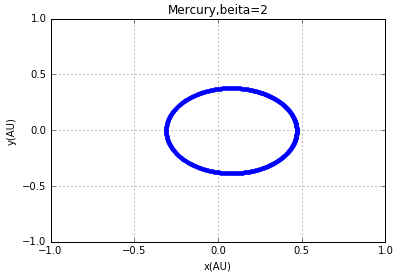
改变β值即有:



3 验证开普勒第三定律与理想值的比较
程序为:
import pylab as plimport mathdef initial(a,e,MP):MS=2*10**(30)x0=a*(1+e)y0=0vx0=0vy0=2*math.pi*math.sqrt((1-e)/(a*(1+e))*(1+MP/MS))return [x0,y0,vx0,vy0]class orbits():def __init__(self,x0,y0,vx0,vy0):self.x=[x0]self.y=[y0]self.vx=[vx0]self.vy=[vy0]self.dt=0.001self.t=[0]self.steps=300001self.r=[]self.x2=[]self.y2=[]self.t2=[]def calculate(self):for i in range(self.steps):self.r.append(math.sqrt(self.x[i]**2+self.y[i]**2))temp_vx=self.vx[i]-4*math.pi**2*self.x[i]*self.r[i]**(-3)*self.dtself.vx.append(temp_vx)temp_x=self.x[i]+self.vx[i+1]*self.dttemp_vy=self.vy[i]-4*math.pi**2*self.y[i]*self.r[i]**(-3)*self.dtself.vy.append(temp_vy)temp_y=self.y[i]+self.vy[i+1]*self.dtself.x.append(temp_x)self.y.append(temp_y)self.t.append(self.t[i]+self.dt)if self.y[i+1]<0:self.y2.append(self.y[i+1])self.x2.append(self.x[i+1])self.t2.append(self.t[i+1])a=(self.x[0]-self.x2[0])/2T=self.t2[0]*2print(a,T,T**2/a**3)return self.x,self.y,self.x2,self.y2def show_result(self):pl.plot(self.x,self.y,".")pl.xlabel('x(AU)')pl.ylabel('y(AU)')pl.xlim(-1.5,1.5)pl.ylim(-1.5,1.5)pl.title('simulation of elliptical orbit')pl.show()I_v=initial(0.72,0.007,4.9*10**(24))v=orbits(I_v[0],I_v[1],I_v[2],I_v[3])v.calculate()v.show_result()I_e=initial(1,0.017,6*10**(24))e=orbits(I_e[0],I_e[1],I_e[2],I_e[3])e.calculate()e.show_result()I_ma=initial(1.52,0.093,6.6*10**(23))ma=orbits(I_ma[0],I_ma[1],I_ma[2],I_ma[3])ma.calculate()ma.show_result()I_j=initial(5.2,0.048,1.9*10**(27))j=orbits(I_j[0],I_j[1],I_j[2],I_j[3])j.calculate()j.show_result()I_s=initial(9.54,0.056,5.7*10**(26))s=orbits(I_s[0],I_s[1],I_s[2],I_s[3])s.calculate()s.show_result()
运行结果为:

结论
由上面运行结果可以看出基本可以模拟出行星运动的轨迹,同时也可以开普勒第三定律验证时与理想值还是有一定差距的,而误差来源可能是每一步的时间距离以及点数选取太少。
致谢
感谢陆文龙同学的耐心帮助。
